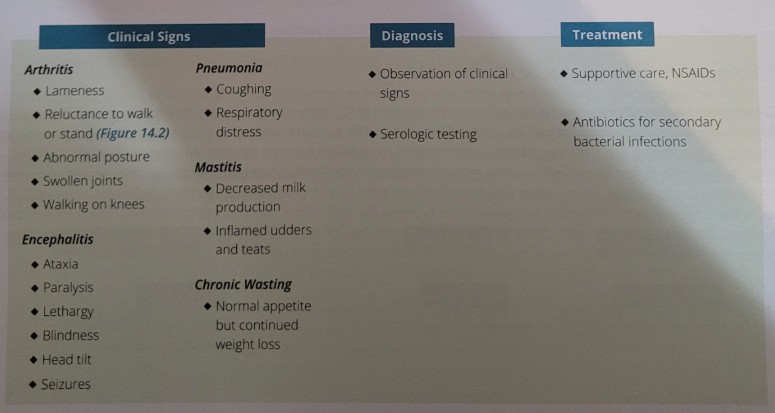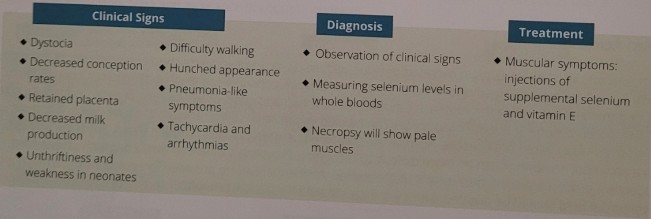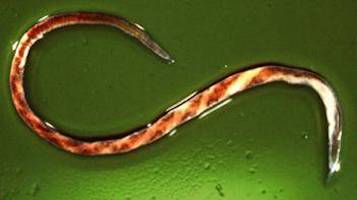ovine and caprine diseases
1/29
Earn XP
Description and Tags
food animal clinical management
Name | Mastery | Learn | Test | Matching | Spaced |
|---|
No study sessions yet.
30 Terms
notifiable diseases
voluntarily reportable to state and local authoriites by the practitioner and will also vary according to state and county
reportable disease
vary by state and county and each state has its own laws that define what diseases are reportable. diagnosis of a reportable disease requires the vet by law to notify appropriate vet officials for the state or county where the diagnosis was made.
blackleg
prevalent in cattle, is also fatal in goats and sheep. caused by spore forming bacteria Clostridium chauvoei which live in the soil for years. enters the animal orally, moves into the body via digestive tract, and then proceeds to muscle and tissue. the spores destroy muscle and produce a gas that can be felt underneath the skin (crepitus) muscle becomes necrotic and swollen. animal may be found dead before exhibiting signs. treatment usually ineffective due ot rapid progression. preventable by vaccination, often combined with other clostridial strains

bluetongue
viral disease transmitted by vectors such as gnats or midges of culicoides genus. most severe in sheep but goats are also susceptible. the lips and tongue become swollen, causing the tongue to protrude form the mouth and turn bluish in color. not contagious but spread by fomites. pregnant ewes infected during first trimester may have reproductive problems including resorption, abortion, or birth of dummy lamb (unable to nurse). reportable disease. vaccine is available to sheep. insect control and avoiding contaminated fomites are key to prevention.

caprine arthritis encephalitis CAE
viral reportable disease only seen in goats. spread from doe to kid via infected milk or among herd by direct contact with infected body fluids and feces. not all goats infected progress to disease. manifests in five way: arthritis, encephalitis, pneumonia, mastitis, and chronic wasting. In kids, encephalitis is the most common sign. adult goats usually display arthritis. chronic wasting form may appear separately or simultaneously with other clinical signs. encephalitis form is typically fatal even with treatment. no vaccine for CAE prevention is best by purchasing goats that have been tested and are negative for the virus and maintaining a closed herd. if tested positive should be culled immediately

caseous lymphadenitis (CL or CLA)
chronic contagious bacterial disease caused by Corynebacterium pseudotuberculosis. can affect both internal and external lymph nodes of goats and sheep. external form is most common in goats. internal form most common in sheep. transmission occurs most often via bacteria invading open wounds or mucous membranes, but can also occur via ingestion of feed or contamination of equipment form an infected animal with draining abscesses. in goats teh drainage from the abscess is very thick, in sheep the abscess forms layers like an onion. a vaccine is available but prevention is better. adhere to strict biosecurity on the farm including prepurchase screening and quarantine of incoming animals. remove environmental hazards that cause breaks in teh skin and disinfecting equipment. animals remain infected for life but may pass months or years after the outbreak of abscesses.

chlamydial abortion (enzootic abortion of ewes) EAE
transmitted by inhalation or ingestion exposure to aborted fetuses and afterbirth, as well as vaginal discharge and feces contaminated by bacteria Chlamydophila abortis. transmission can occur during breeding and infected animals can become carriers. some should be culled but new recommendations include vaccinating any incoming animals and retaining the infected sheep as they will maintain a high level of flock immunity. a modified live vaccine is available in europe but not the us. if present the entire flock should be treated with long acting tetracycline during gestation to reduce losses. if came into contact use long acting tetracycline or oxytetracycline.

contagious ecthyma ORF, sore mouth
highly contagious zoonotic disease by a parapoxvirus. it is transmitted by direct contact with infected animals and also contaminated fomites such as milking equipment. in sheep and goats, the disease manifests in crusty, proliferative lesions on the body, mouth, and muzzle, and is often more severe in goats. lambs more commonly have mouth, lip, and muzzle lesions. adults have lesions of the eyes, feet, udder, and genitalia. goats typically have more severe clincial signs. lesions will resolve in about 3-6 weeks. humans infected via direct contact with lesions, leading to ulcerative lesions on their hands. prevented by vaccination which is a live virus so proper precautions and PPE should be used when adminstering. additional preventative measures include isolating infected animals and quarantining new animals before mixing with the heard

enterotoxemia
severe disease of both goats and sheep caused by bacteria Clostridium perfingens which produces potent toxins. commonly found in soil and its spores can survive for long periods. found in digestive tracts of many animals. four types C. perfingens: type A,B,C,D. Type A is normal flora and rarely produces enough toxin to cause illnesses.
Type B: also known as lamb dysentery, causes intestinal disease in lambs during the first week of life
Type C: causes hemorrhagic and necrotic enteritis
Type D- also known as overeating disease or pulpy kidney disease; more common with sheep.
enterotoxemia occurs when bacteria counts rapidly increase in teh body and animals immune system is unable to destroy offending bacteria. usually caused by stress or sudden changes made to diet. animals on high grain or lush green pastures are higher incidences due to increased amounts of starch. B,C,D are preventable with a good vaccination protocol, prevention includes proper feeding guidelines such as avoiding abrupt changes in diet and adhering to feeding schedule,

foot scald, foot rot
contagious diseases of the hooves in both goats and sheep. Foot scald caused by bacteria Fusobacterium necrophorum, found in feces and in grazed pastures. It invades the foot. Foot rot caused by Dichelobacter nodosus found in contaminated soil. is a secondary infection to produce the more severe foot rot. Foot scald is interdigital dermatitis with primary infectious agent F. necrophorum. Both result in lameness. spread by heard or flock by the introduction of infect animal. wet, muddy environment conditions, areas with accumulated manure, and poor hoof care and trimming are predisposing factors to this disease. prevention involves proper hoof trimming. trimming long hair on the hooves to allow faster drying

Listeriosis (circling disease)
infectious bacterial disease of goats and sheep caused by listeria monocytogenes. commonly found in soil, feces, and digestive tract of mammals. disease is result of ingestion or inhalation of microorganism. may result in encephalitis, septicemia, and abortion when the microorganism enters teh body via an open wound or tissue. in sheep, the most common form is referred to as circling disease. causes neurologic symptoms in that species with inflammation on one side of hte brain, resulting in unilateral signs such as circling, disorientation, and lethargy. zoonotic transmission is possible, especially if handling aborted fetuses and deceased animals. infected milk is also potential source. no vaccine so prevention is key.

ovine progressive pneumonia (OPP)
viral disease in sheep caused by lentivirus or the retrovirus family, causing a slowly progressing disease. causes respiratory symptoms and less often neurologic. OPP is closely related to CAE in goats with similar signs. most commonly sheep are asymptomatic but spread teh virus via direct contact and through infected milk. they shed the virus for life. no effective treatemtn or vaccines are available. most sheep die of secondary bacterial pneumonia.
Q fever
zoonotic and reportable disease caused by bacteria coxiella burnetii, an organism that can survive in the environment for months and can be resistant to heat, drying and many disinfectants. quite responsive to antibiotics. sheet tend to be infected more often but both are carriers. shed in feces. bacteria takes on spore like form and contaminates dust that is spread by wind. humans can contract the disease via contact with infected afterbirth, animals, urine, unpasteurized milk, feces, and wool. ewes and does can also become carriers of the disease, in turn passing it along in milk. animals often asymptomatic but carriers and should be culled. no approved vaccine of animals but there is one for at risk humans.

scrapie
classified as a transmissible spongiform encephalopathy (TSE) and is fatal, degenerative disease affecting the nervous systems of goats and sheep. Prions are abnormal proteins that affect the cns and can be transmitted via body, fluids, feces, infected milk, and through the placenta. main routes are via ingestion or breaks in the skin. it is higly contagious, infecting sheep more often than goats. there is a national scrapie eradication program that involves genetic testing and slaughter of susceptible animals

tetanus (lockjaw)
deadly disease caused by a toxin produced by bacterium Clostridium tetani. naturally found in soil and manure. treatment is available but has low success rates. A vaccine is available in combination or multivalent with other clostridia. routine vaccine of entire flock is highly recommended.

Vibriosis
zoonotic disease caused by Campylobacter jejuni or Campylobacter fetus. cause of abortion in sheep and goats. more common in sheep. transmitted by pregnant ewe or doe ingests contaminated feed or is exposed to contaminated aborted tissue. abortions typically occur in the last 6 weeks of gestation. prevented by vaccination or using tetracycline in feed.

copper toxicity
occurs from ingestion and accumulation of excess copper over time in the liver. liver is unable to store the excess and can release copper all at once into the bloodstream. sheep are most commonly affected. sheep must only eat sheep food. if raised together; give both species sheep feed. chronic toxicity is more common. causes destruction of red blood cells, jaundice, and liver damage. treatment includes ammonium molybdate or sodium sulfate to reduce absorption of copper.

polioencephalomalacia (PEM)
a metabolic disorder in sheep and goats. occurs as result of a thiamine (vitamin B) deficiency or a high sulfur intake form feed or water. also caused by pregnancy toxemia in sheep, acute lead poisoning, or water deprivation. most often seen in weanling kids and lambs. can be acute or subacute, initial signs are partial to full blindness. treat with gradual change in diet or adequate fiber intake. supplementation of thiamine has shown success.

pregnancy toxemia (ketosis) (twin lamb disease)
affects sheep and goat during late gestation and early lactation, caused by abnormal metabolism of carbohydrates and fats. nutrient requirements are not met, so the mom depletes there own fat reserves. causing ketones in the blood which have toxic effect in large concentrations.

rumen acidosis, grain overload, lactic acidosis
disease of carbohydrate fermentation disorder of the rumen. caused by improper feeding practices. animal consumes too much grain and not enough fiber. changes pH of rumen becoming acidic. acute or subacute. acute acidosis is rare but often results in sudden death.

urinary calculi
disorder affecting male goats and sheep. typically due to dietary mismanagement resulting in an abnormal a phosphorus to calcium ratio that causes solid particles or calculi to obstruct the urethra. animals castrated at a young age are at higher risk for developing this condition due to the absence of testosterone, which causes cessation of urethral growth. needs immediate treatment or death. use tranquilizers and antiposmodics to help dislodge of some calculi. delay castration.

white muscle disease
deficiency in selenium and vitamin E. affects both goats and sheep. stored food for more than a month can degrade vitamin E.

keds
Malophagus ovinus, wingless fly similar to tick. spend their entire life cycle on the host and spread. larva will suck blood. use insecticides older than 3 months of age

lice
two types of lice (biting and sucking) sucking lice will penetrate the skin and cause blood loss. biting lice will feed off of the skin surface.

barber pole worm
haemonchus contortus. blood sucking worm that affects ruminants and can cause severe anemia. tapered at both ends. females are red and white striped like barber pole. males are solid red and smaller. larva climb grass blades. adults attach to abomasum.

brown stomach worm
Teloddorsgia circumcincta, roundworm of sheep and goats. limits animals ability to absorb nutrients. may cause bottle jaw seen in heavy parasite load.

Hairworm
roundworm Trichostrongylus colubriformis, damage to small intestine and stomach of both goats and sheep. adults are small and slender with reddish brown coloring.

liver fluke
Fasciola hepatica, most common. found in biliary ducts, gallbladder, and liver. common in wet and damp areas and depend on snails to complete life cycle. death can occur in 2-6 weeks. can cause chronic liver damage

tapeworm- hydatid
Echinococcus granulosus reside in liver and lungs. sheep and goats are intermediate host while carnivores are definitive host. the larvae form a cyst in the liver, and lungs. cysts will rupture if not taken off and cause death.

Tapeworm monezia expansa
found in small intestines. require pasture mites. mites ingest tapeworm eggs. large number of tapeworm can cause impaction and death
